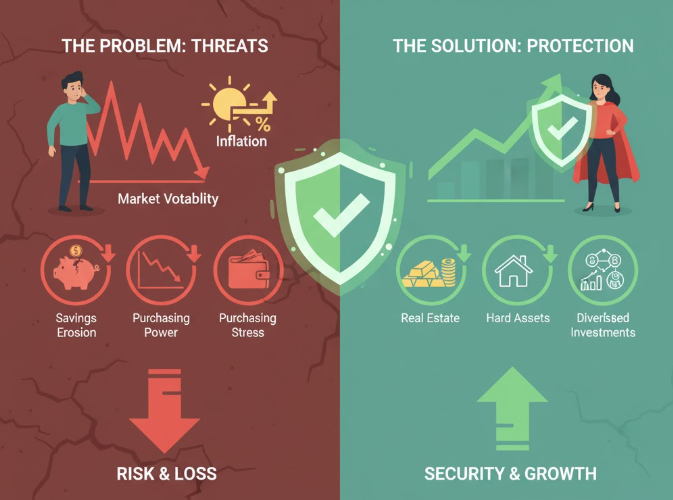Introduction: The Hidden Threats to Your Hard-Earned Money
You work hard for your money — saving it, investing it, and planning for the future. But two invisible forces can quietly eat away at your wealth if you’re not prepared: inflation and market volatility.
Inflation makes your money lose value over time — what cost $100 last year may cost $110 this year. Meanwhile, market volatility can cause your investments to swing wildly, sometimes cutting your portfolio’s value in half overnight.
But here’s the good news — you can protect yourself. With the right mix of strategies, smart asset allocation, and disciplined planning, your wealth can not only survive inflation and volatility — it can grow stronger.
In this guide, we’ll explore practical, easy-to-understand strategies to safeguard your money and make it work for you in uncertain times.
What Really Happens During Inflation
Inflation occurs when prices rise, and each dollar buys fewer goods and services. It’s like a slow leak in your financial bucket — even if your savings balance stays the same, its buying power shrinks.
How Inflation Impacts You:
-
Savings lose value: If inflation is 7%, and your bank pays 2% interest, you’re losing 5% purchasing power every year.
-
Living costs increase: Groceries, rent, gas, and utilities become more expensive.
-
Investments fluctuate: Bonds and fixed returns lose appeal as inflation eats into real returns.
📊 Example Table: How Inflation Reduces Purchasing Power
| Year | Inflation Rate | Value of $10,000 (Real Buying Power) |
|---|---|---|
| 0 | 0% | $10,000 |
| 5 | 5% | $7,835 |
| 10 | 5% | $6,139 |
| 20 | 5% | $3,769 |
In just 20 years, a steady 5% inflation cuts your money’s buying power by more than half. That’s why smart investing is essential — to beat inflation’s quiet erosion.
Market Volatility: Why It’s Both a Risk and an Opportunity
Market volatility means sharp ups and downs in asset prices — whether in stocks, crypto, or commodities. While it can feel scary, volatility is also what creates opportunity.
The Good and the Bad:
-
Bad: Sharp downturns can cause big short-term losses.
-
Good: Volatility allows disciplined investors to buy quality assets at lower prices.
Think of volatility like ocean waves. If you panic and jump off the boat during a storm, you lose. But if you stay steady and adjust your sails, you’ll eventually reach calmer waters — and possibly faster.
Step-by-Step Plan to Protect Wealth from Inflation and Volatility
1. Diversify Across Asset Classes
The golden rule of wealth protection is simple: Don’t put all your eggs in one basket.
A diversified portfolio spreads risk across different assets so that if one category falls, another may rise.
Smart Diversification Mix
| Asset Type | Inflation Protection | Volatility Resistance | Example |
|---|---|---|---|
| Stocks | Moderate | Moderate | Dividend-paying blue chips |
| Bonds | Low | High | Treasury Inflation-Protected Securities (TIPS) |
| Real Estate | High | Moderate | Rental properties, REITs |
| Commodities | High | High | Gold, silver, oil |
| Cash | Low | Low | Emergency fund |
| Cryptocurrencies | Very High | Very High | Bitcoin, Ethereum (limited exposure) |
Tip: The key is balance. Don’t chase returns — seek stability.
2. Invest in Real Assets
When paper money loses value, tangible assets often hold strong. Real estate, precious metals, and commodities have a long history of outperforming during inflationary periods.
Top Real Assets to Consider:
-
Real Estate: Property values and rents usually rise with inflation.
-
Gold & Silver: Traditional inflation hedges that retain value.
-
Commodities: Oil, agriculture, and metals benefit when prices rise globally.
🪙 Example: During the 1970s U.S. inflation crisis, gold prices soared nearly 1,800% — from $35 to $650 per ounce.
3. Choose Inflation-Resistant Investments
You can’t stop inflation, but you can invest in tools that adjust with it.
Best Inflation-Linked Investments:
-
Treasury Inflation-Protected Securities (TIPS): U.S. government bonds that automatically adjust with inflation rates.
-
Dividend-Paying Stocks: Companies with consistent profit growth tend to increase dividends over time, helping investors stay ahead of inflation.
-
Index Funds & ETFs: Low-cost, diversified funds tracking markets often beat inflation in the long term.
💡 Pro Tip: Avoid holding too much cash for long periods. While safe, cash slowly erodes under inflation’s pressure.
4. Build an Emergency Fund
When markets crash or prices spike, an emergency fund is your financial safety net.
How Much to Save:
-
3–6 months of living expenses minimum
-
Store in high-yield savings accounts or money market funds
-
Avoid locking it in long-term deposits during rising inflation
Having an emergency fund ensures you don’t sell investments at a loss during market downturns.
5. Focus on Long-Term Investing
The biggest mistake investors make during volatility? Panic selling.
Short-term drops are natural — but historically, markets always recover and reach new highs.
For example:
-
The 2008 financial crisis saw global markets crash 50%… yet they fully recovered within 5 years.
-
The 2020 COVID crash wiped trillions but rebounded in months.
Long-Term Strategies That Work:
-
Dollar-Cost Averaging: Invest the same amount regularly, buying more when prices drop.
-
Rebalance Yearly: Adjust portfolio weights to maintain risk tolerance.
-
Ignore Short-Term Noise: Focus on your 5–10-year goals, not daily charts.
📈 Illustration: Long-Term Growth vs. Panic Selling
| Investor Type | Market Reaction | 10-Year Return |
|---|---|---|
| Stayed Invested | Held through dips | +90% |
| Sold in Panic | Missed recovery | +25% |
| Timed Market | Bought high, sold low | +10% |
Patience beats panic every single time.
6. Strengthen Multiple Income Streams
One of the best defenses against inflation is earning more — especially through inflation-adjusted or passive income sources.
Examples of Resilient Income Streams:
-
Rental Income: Rent typically increases alongside inflation.
-
Dividends: Companies that share profits with investors provide steady cash flow.
-
Freelance or Side Businesses: Offers flexibility and control over income growth.
-
Online Ventures: Blogs, digital products, or eCommerce can scale globally.
🔑 The goal is simple: Don’t depend on one paycheck — build multiple sources that grow even when prices rise.
7. Minimize High-Interest Debt
Inflation can sometimes help borrowers by reducing debt value, but high-interest loans — like credit cards — can destroy wealth fast.
Debt-Proof Your Finances:
-
Pay off credit card balances monthly.
-
Refinance high-interest loans during low-rate periods.
-
Avoid variable-rate loans when inflation is rising — interest costs can spike.
Every dollar you don’t pay in interest is a dollar you keep earning.
8. Consider Alternative Investments
Beyond traditional stocks and bonds, alternative assets can add resilience and diversification.
Potential Alternatives:
| Category | Description | Risk Level |
|---|---|---|
| Peer-to-Peer Lending | Earn interest by lending money online | Moderate |
| Private Equity | Invest in startups or private firms | High |
| Collectibles | Art, watches, rare cars, NFTs | High |
| Cryptocurrencies | Decentralized digital assets | Very High |
These options can outperform during inflation, but limit exposure to 10–15% of your total portfolio to manage risk.
9. Use Tax-Advantaged Accounts
Inflation silently eats returns, but taxes take an even bigger bite.
Use legal tools to protect your income and investments.
Smart Tax Strategies:
-
Retirement Accounts: IRAs or 401(k)s defer or eliminate taxes on investment growth.
-
Health Savings Accounts (HSAs): Triple tax benefits for medical expenses.
-
Municipal Bonds: Offer tax-free interest in many cases.
💰 Every dollar you save in taxes is another shield against inflation.
10. Stay Educated and Adapt
Markets change, inflation rises and falls, but one rule remains — financial knowledge compounds like money.
Ways to Stay Ahead:
-
Read books and reliable financial blogs.
-
Follow long-term investors, not short-term traders.
-
Review your portfolio every 6–12 months and adjust for new conditions.
Adaptability, not prediction, separates lasting wealth builders from those who get left behind.
Bonus Section: Inflation-Proof Lifestyle Adjustments
Protecting wealth isn’t just about investing — it’s also about how you spend and live.
Smart Lifestyle Moves:
-
Buy durable goods, not disposable ones. Long-lasting items save money in the long run.
-
Invest in skills that increase your earning power. Education beats inflation.
-
Negotiate prices and rates regularly. From internet bills to insurance — everything’s negotiable.
-
Grow your own food or start DIY projects. Small savings add up during inflationary times.
-
Embrace digital tools for budgeting. Apps like Mint or YNAB help track spending and inflation impact.
By blending smart investing with wise living, you build true financial resilience.

Infographic: 7 Pillars of Inflation-Proof Wealth
Visual Summary (described below):
| Pillar | Focus Area | Impact |
|---|---|---|
| 1 | Diversification | Reduces risk |
| 2 | Real Assets | Hedge against inflation |
| 3 | Long-Term Investing | Stabilizes growth |
| 4 | Emergency Fund | Provides liquidity |
| 5 | Multiple Incomes | Strengthens cash flow |
| 6 | Debt Control | Frees capital |
| 7 | Continuous Learning | Sustains adaptability |
Sample Balanced Portfolio During Inflation
| Asset Class | Allocation | Purpose |
|---|---|---|
| U.S. Stocks (Blue-Chip) | 30% | Long-term growth |
| International Stocks | 10% | Geographic diversification |
| Bonds (TIPS) | 15% | Inflation protection |
| Real Estate (REITs) | 15% | Passive income |
| Commodities (Gold/Silver) | 10% | Hedge |
| Cash/Money Market | 10% | Emergency reserve |
| Alternative Assets | 10% | Additional diversification |
🧭 Goal: Moderate risk, steady growth, and inflation resistance.
Common Mistakes to Avoid
-
Keeping all savings in cash.
-
Chasing high returns during volatility.
-
Ignoring inflation’s long-term effect.
-
Selling quality assets in panic.
-
Failing to review portfolio yearly.
Avoiding these traps can save you thousands — if not millions — over your lifetime.
Conclusion: Build Wealth That Withstands Time
Inflation and market volatility are part of every economy — but they don’t have to destroy your financial future.
By diversifying your investments, focusing on real assets, maintaining an emergency fund, and thinking long-term, you transform uncertainty into opportunity.
Wealth protection isn’t about fear — it’s about preparation. When you stay calm, invest wisely, and keep learning, your money becomes more than a number — it becomes a shield for your freedom, security, and future generations.
Key Takeaways
-
Inflation quietly erodes your money’s value.
-
Diversification, real assets, and inflation-protected securities are your best defense.
-
Keep a long-term view — panic and fear are your real enemies.
-
Build multiple income streams to outpace inflation.
-
Knowledge and adaptability will always beat market chaos.

